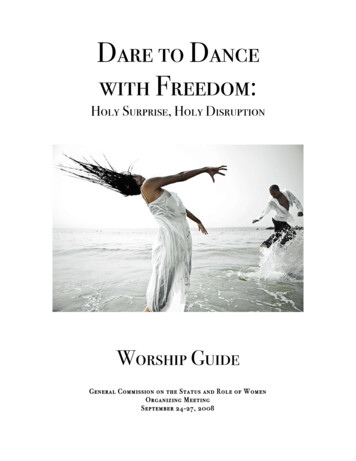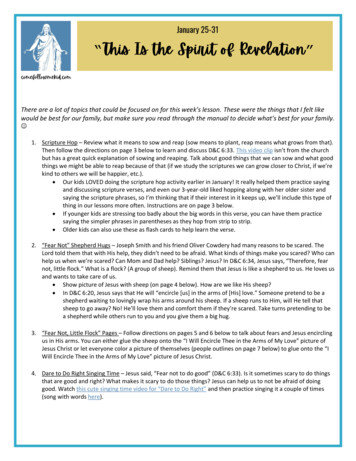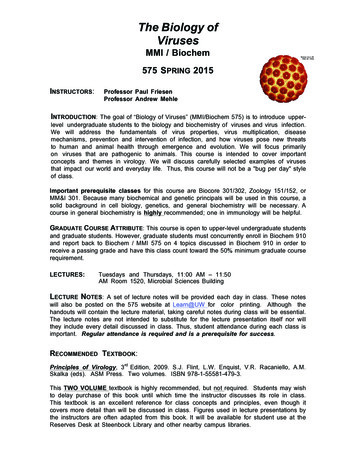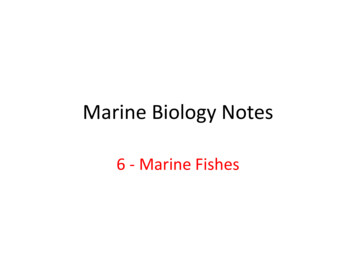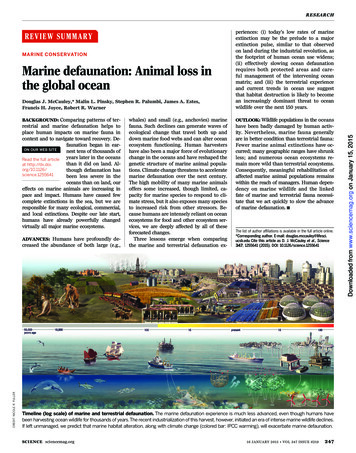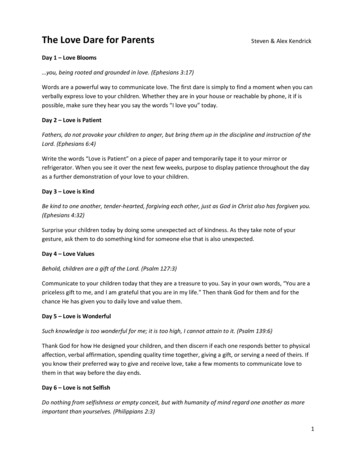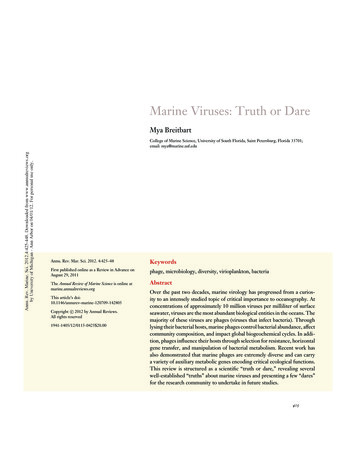
Transcription
MA04CH17-BreitbartARI3 November 201117:38Marine Viruses: Truth or DareMya BreitbartAnnu. Rev. Marine. Sci. 2012.4:425-448. Downloaded from www.annualreviews.orgby University of Michigan - Ann Arbor on 04/01/12. For personal use only.College of Marine Science, University of South Florida, Saint Petersburg, Florida 33701;email: mya@marine.usf.eduAnnu. Rev. Mar. Sci. 2012. 4:425–48KeywordsFirst published online as a Review in Advance onAugust 29, 2011phage, microbiology, diversity, virioplankton, bacteriaThe Annual Review of Marine Science is online atmarine.annualreviews.orgThis article’s doi:10.1146/annurev-marine-120709-142805c 2012 by Annual Reviews.Copyright !All rights reserved1941-1405/12/0115-0425 20.00AbstractOver the past two decades, marine virology has progressed from a curiosity to an intensely studied topic of critical importance to oceanography. Atconcentrations of approximately 10 million viruses per milliliter of surfaceseawater, viruses are the most abundant biological entities in the oceans. Themajority of these viruses are phages (viruses that infect bacteria). Throughlysing their bacterial hosts, marine phages control bacterial abundance, affectcommunity composition, and impact global biogeochemical cycles. In addition, phages influence their hosts through selection for resistance, horizontalgene transfer, and manipulation of bacterial metabolism. Recent work hasalso demonstrated that marine phages are extremely diverse and can carrya variety of auxiliary metabolic genes encoding critical ecological functions.This review is structured as a scientific “truth or dare,” revealing severalwell-established “truths” about marine viruses and presenting a few “dares”for the research community to undertake in future studies.425
MA04CH17-BreitbartARI3 November 201117:38INTRODUCTIONPhage: a virus thatinfects a bacterialhost; short forbacteriophageAnnu. Rev. Marine. Sci. 2012.4:425-448. Downloaded from www.annualreviews.orgby University of Michigan - Ann Arbor on 04/01/12. For personal use only.Lysogeny: lifestyleof temperate phages,which integrate intothe host’s genome orare maintained asplasmids until aninduction eventtriggers the lytic cycleThe first phage isolated from the marine environment was reported more than 50 years ago(Spencer 1955), but not until the abundance of viruses was recognized in the late 1980s didscientists begin to consider their ecological impacts in the oceans (Bergh et al. 1989). It is nowwell accepted that viruses are abundant and ecologically important components of the marineenvironment. Although viruses infect all organisms from bacteria to whales, this review focuses onmarine phages (viruses that infect bacteria) in the water column (for a review on benthic viruses, seeDanovaro et al. 2008a). To celebrate the field of marine virology reaching its early twenties, thisreview plays a scientific version of “truth or dare,” detailing several “truths” about marine virusesthat have emerged over the past two decades of intensive study and presenting a few “dares” tothe research community regarding exciting avenues for future study.TRUTH: VIRUSES ARE THE MOST ABUNDANT BIOLOGICALENTITIES IN THE OCEANSIt is difficult to find a paper in marine viral ecology that does not begin with a statement aboutthe sheer abundance of viruses. In fact, it was the recognition of the abundance of viruses thatdrew attention to the field of marine virology in the late 1980s (Bergh et al. 1989, Børsheimet al. 1990, Proctor & Fuhrman 1990). Before this time, the presence of viruses in seawater wasknown (Anderson et al. 1967, Moebus & Nattkemper 1981, Torrella & Morita 1979); however,viruses were not thought to be abundant enough to have significant ecological impacts. In the pasttwo decades, methods for direct counts have evolved from transmission electron microscopy toepifluorescence microscopy and flow cytometry, and viruses have been enumerated from thousandsof samples throughout the world’s oceans (Suttle & Fuhrman 2010).There are an average of 107 virus-like particles per milliliter of surface seawater. This makesviruses approximately an order of magnitude more abundant than prokaryotes, which are the second most abundant biological group (Wommack & Colwell 2000). With total estimated numbersof 1030 in the oceans, viruses are by far the most abundant predators in the marine environment.For example, compare their average concentration of 107 viruses per milliliter to the averagenumber of great white sharks per milliliter, which is only 10 19 . Viral concentrations in the oceansare approximately 17 femtomolar (fM). By contrast, if the entire human population (6.9 billionpeople) went swimming in the oceans simultaneously, humans would reach a concentration ofonly 10 20 fM in the oceans. Despite their small size ( 100 nm; 10–200 fg), viruses compose theocean’s second largest biomass, exceeded only by the total biomass of prokaryotes (Suttle 2005).Viral abundance is generally highest in the euphotic zone and then decreases exponentiallywith depth, although subsurface maxima in viral abundance have been observed at several sites(Boehme et al. 1993, Hara et al. 1996, Parsons et al. 2011, Wommack & Colwell 2000). Typically,viral abundance is higher in coastal environments than in offshore waters (Cochlan et al. 1993,Marchant et al. 2000). Seasonal variations in viral abundance, the virus-to-bacteria ratio, and thedegree of lysogeny have also been observed, demonstrating the dynamic nature of marine viralcommunities (Paul 2008, Weinbauer et al. 1995, Wommack & Colwell 2000).DARE: EXPAND THE SPATIAL AND TEMPORALSCOPE OF VIRAL STUDIESMost studies of marine viruses examine a small number of samples, each representing a snapshotof the viral community composition and activity in time and space. Because viral and bacterial426Breitbart
MA04CH17-BreitbartARI3 November 201117:38communities are extremely dynamic in nature, snapshots of the viral community are inadequatefor describing the microbial ecology of marine systems (Hewson et al. 2006), especially withoutan understanding of the degree of spatial and temporal variability that exists.Annu. Rev. Marine. Sci. 2012.4:425-448. Downloaded from www.annualreviews.orgby University of Michigan - Ann Arbor on 04/01/12. For personal use only.Temporal VariabilitySince the first studies that enumerated viruses, it has been known that there are seasonal variationsin viral abundance (Bergh et al. 1989, Jiang & Paul 1994). Typically, viral abundance is higher insummer and autumn than in winter (Wommack & Colwell 2000). Although seasonal variabilityhas been demonstrated at several marine sites, few studies have followed the seasonal changes overmore than one year to determine whether these patterns repeat annually. The only multiyear timeseries to examine viruses in the open ocean demonstrated seasonally recurring patterns in viralabundance in the Sargasso Sea that corresponded to changes in water-column stability and the distribution of specific bacterioplankton lineages (Parsons et al. 2011). Overall, marine virology wouldstrongly benefit from the incorporation of viruses into more long-term time-series programs.At the other end of the temporal spectrum, little work has been done to examine variabilityin the viral community over short time periods. A study in the Indian Ocean demonstrated thatthe number of culturable Synechococcus phages from surface waters varied significantly over a 24-hperiod, with a peak in abundance at 0100 hours (Clokie et al. 2006). These temporal dynamics arelikely determined by host metabolic processes and sunlight-induced decay rates; however, futurework needs to determine if the temporal dynamics are similar for other phage-host pairs. Winget& Wommack (2009) demonstrated significant variations in viral production rates over 24-h cyclesin the Chesapeake Bay; however, they did not observe a correlation between viral production andtime of day (Winget & Wommack 2009). A study in the North Sea determined that the frequencyof infected cells was generally higher at night than in the daytime and suggested that infectionoccurred mainly during the night, with viral lysis of bacteria occurring in the afternoon (Winteret al. 2004a). Viral production and cell lysis generally corresponded with times of high bacterial activity, which the authors suggested was a strategy to optimize the number of viral progeny. Studiesexamining total viral abundance over diel cycles using epifluorescence microscopy have producedconflicting results in terms of the time of maximal viral abundance. In the northwest Mediterranean Sea, viral abundance was maximal at midday (1800 hours) (Bettarel et al. 2002). By contrast,studies in Tampa Bay, Florida, ( Jiang & Paul 1994) and in the northern Adriatic Sea (Weinbaueret al. 1995) demonstrated that peaks in viral abundance followed peaks in bacterial abundance withno clear diel patterns. Despite these conflicting results, there is clearly strong temporal variabilityin viral dynamics, and differences over short time scales (i.e., the time of day that samples arecollected) likely have significant implications for comparing data from viral abundance studies.Spatial VariabilityAlthough individual studies have examined viral distribution, diversity, and dynamics at varioussites throughout the world’s oceans, temporal effects and differences in methodologies makeit difficult to compare these studies. Owing to the large efforts and funding required, thereis a paucity of large-scale studies encompassing multiple oceanic regions. In one such study,Yang et al. (2010) used flow cytometry to examine the distribution of viruses in surface watersthroughout the Pacific and Southern oceans. This study found that the integrated viral abundancein the upper 200 m of the water column was high in the subtropical and tropical regions andlower in the Antarctic region. Variation in the abundances of photoautotrophic picoplankton(Synechococcus, picoeukaryotes, and Prochlorococcus) accounted for 57% of the variability inwww.annualreviews.org Marine Viruses: Truth or Dare427
ARI3 November 201117:38viral abundance, suggesting that cyanophages are an important component of marine viralassemblages. Similarly, Bettarel et al. (2002) found linkages between Synechococcus and total viralabundance in the northwestern Mediterranean Sea and a decadal time series in the Sargasso Searevealed a strong correlation between the abundances of viruses and Prochlorococcus (Parsons et al.2011). By contrast, an extensive study in the Adriatic Sea determined that viral abundance wasindependent of autotrophic biomass or other environmental parameters, instead correlating withturnover times of the bacterial community (Corinaldesi et al. 2003). These differing results maybe due to sampling location, as the correlations between viral abundance and several other bioticvariables vary between different oceanic regions (Yang et al. 2010).Although viral infection dynamics are typically assessed in “bulk seawater,” the oceans are extremely heterogeneous and should be envisioned as a continuum of particles rather than as clearblue water (Azam 1998, Simon et al. 2002). Indeed, significant heterogeneity in viral abundanceoccurs over extremely small spatial scales. Using flow cytometry, Seymour et al. (2006) demonstrated microscale patchiness in viral and bacterial abundance at centimeter-scale spatial resolutionin marine systems. Unlike the fairly stable virus to bacteria ratio (VBR) of approximately 10 thatis observed on bulk scales, at the centimeter-scale, there was no correlation between bacterialand viral abundance, with VBRs varying more than tenfold (Seymour et al. 2006). The authorssuggested that local areas of elevated viral abundance (i.e., “hot spots”) could result from the association of viruses with patches of host organisms, the adsorption of viruses to particulate matter, orthe slower diffusion of viruses relative to bacterial motility away from patches. In some cases, highlocal viral abundance correlated with low local bacterial abundance, potentially reflecting a recentlysis event. This study demonstrated that averaging over large spatial scales may provide an inaccurate view of phage-host interactions (Figure 1). Despite the challenges of sampling on smallAbundancebAbundanceaBulk abundanceRankRankAbundanceRankAbundanceAnnu. Rev. Marine. Sci. 2012.4:425-448. Downloaded from www.annualreviews.orgby University of Michigan - Ann Arbor on 04/01/12. For personal use only.MA04CH17-BreitbartRankRankFigure 1Parameters measured in bulk seawater samples may not accurately reflect phage-host interactions on local scales owing to the highdegree of spatial heterogeneity in the oceans. (a) Most seawater samples appear to have extremely even viral communities; however, thismay be an artifact of integrating over many microniches. (b) For example, consider a seawater sample that contains four particles, eachdominated by a different phage type. The rank-abundance curve for the bulk sample in panel a does not accurately portray local phagediversity or interactions.428Breitbart
Annu. Rev. Marine. Sci. 2012.4:425-448. Downloaded from www.annualreviews.orgby University of Michigan - Ann Arbor on 04/01/12. For personal use only.MA04CH17-BreitbartARI3 November 201117:38spatial scales, it is important to examine microscale variability in viral abundance and diversitybecause host distribution is highly heterogeneous (Long & Azam 2001) and patchy distributionswill affect specific virus-host interactions.The presence of viruses and infected bacterial cells on particles such as marine snow was recognized extremely early in the history of marine virology (Peduzzi & Weinbauer 1993, Proctor &Fuhrman 1991); however, methodological limitations have made the study of viral ecology on particles extremely difficult. Recent work combining confocal laser-scanning microscopy with lectinand nucleic acid staining demonstrated high viral abundances (ranging from 105 to 1011 viruses permilliliter) on suspended oceanic particles (Weinbauer et al. 2009). In a laboratory-based modelsystem, Riemann & Grossart (2008) found that bacterial colonization of particles significantlyincreased phage production. Because bacteria attached to particles are typically present at higherdensities and often have higher cell-specific activities than free-living bacteria (Grossart et al. 2007,Simon et al. 2002), particles may serve as hot spots of phage production in the oceans (Riemann& Grossart 2008). In addition, continued observation of these particles revealed that, after an initial lysis event, the particles were recolonized by phage-resistant bacterial strains, demonstratingthat the acquisition of phage resistance may be enhanced on particles and may affect temporalphage-host dynamics (Riemann & Grossart 2008).Overall, initial data suggest that particles serve as scavengers of viruses rather than viral factories(Weinbauer et al. 2009). The interactions between viruses, hosts, and particles are complicated,with many potential feedbacks (reviewed in Weinbauer et al. 2009). For example, viral lysis ofhosts influences the formation of particles, the presence of particles affects host growth (whichaffects virus replication), and viral processes influence the fate of particles. If particles scavengeviruses from the water column, viral lysis among the free-living community may be reduced;however, these particles may then serve as viral reservoirs for subsequent infections. Some datasuggest that viral decay rates may be high on aggregates (Simon et al. 2002, Suttle & Chen 1992).The net effect of particles on marine viral ecology is likely to be extremely variable, depending onspecific characteristics of the particles (e.g., composition, quality, size, age) as well as environmentalparameters such as residence time (Weinbauer et al. 2009).The spatial scale on which marine viral communities are examined is often determined bymethodological limitations (e.g., needing to concentrate many liters of water to obtain enoughbiomass for analysis). The degree of small-scale spatial variability in viruses is, therefore, largelyunknown, and as a result, the appropriate spatial scales for examining marine viral communitieshave not been determined (Figure 1). For example, the narrow VBR that is consistently observedin bulk seawater may actually be an average of integrating over a large number of microniches inwhich the VBR varies drastically (Seymour et al. 2006). As methods improve, future studies needto dissect the distribution of viral particles and processes in the ocean to gain an understanding ofthe relevant scales for making these measurements.TRUTH: VIRUSES ARE EFFICIENT KILLERS, AND THROUGHLYSING THEIR HOSTS, MARINE VIRUSES IMPACT GLOBALCARBON AND NUTRIENT CYCLINGOn the most basic level, viruses exist to replicate themselves, a process that most often involveskilling their hosts. The majority of the viruses in the oceans are believed to be phages. By killingbacteria, phages control microbial abundance and release dissolved organic matter, influencingglobal biogeochemical cycles (Weinbauer 2004, Wommack & Colwell 2000). Marine viral communities are extremely dynamic, with production rates ranging from 108 to 1011 viruses per literper day, translating into turnover times of 0.09 to 3.5 days ( Jacquet et al. 2010, Weinbauer 2004,www.annualreviews.org Marine Viruses: Truth or Dare429
MA04CH17-BreitbartARI3 November nicmatterGrazersClassicfood chainAnnu. Rev. Marine. Sci. 2012.4:425-448. Downloaded from www.annualreviews.orgby University of Michigan - Ann Arbor on 04/01/12. For personal use only.HeterotrophicprokaryotesFigure 2Simple diagram of the marine microbial food web, with the viral shunt highlighted in red. Consumption bygrazers shuttles carbon up the traditional food chain into higher trophic levels. By contrast, the viral shuntproduces dissolved organic matter that can be consumed by other prokaryotes, essentially serving as a marinemicrobial recycling program that stimulates nutrient and energy cycling.Wommack & Colwell 2000). Each day, an estimated 1028 viral infections occur in the world’soceans, releasing up to 109 tons of carbon from biological cells (Suttle 2007). In contrast to consumption by grazers, phage lysis of bacteria diverts carbon from the classical food chain (Figure 2).This process, termed the viral shunt, produces dissolved organic matter that can be consumed byother prokaryotes. It is estimated that 25% of the carbon fixed through photosynthesis cyclesthrough the viral shunt (Wilhelm & Suttle 1999), which essentially functions as a marine microbial recycling program that stimulates nutrient and energy cycling (Fuhrman 1999, Suttle 2005,Wilhelm & Suttle 1999).TRUTH: PHAGES ARE NOT JUST RUTHLESS KILLERS;SOME WAIT BEFORE LYSING THEIR HOSTSViral shunt: thetransfer of energy andnutrients from livingorganisms into thedissolved phasethrough the process ofviral lysis430Phages are most commonly thought of as killers (Figure 3). However, not all phages immediatelylyse their hosts upon infection. During lysogeny, temperate phages form a stable interactionwith their hosts, either by integrating into the bacterial chromosome or through maintenance asplasmids. The phage genome is maintained in this “silent” form of infection within a bacteriallysogen until some condition triggers the prophage to become lytic (a process termed induction).Wilcox & Fuhrman (1994) concluded that lytic processes were more important than lysogenyin the oceans, but several studies have found inducible prophages in a high proportion of culturablemarine bacteria. As determined by chemical induction, approximately half of bacterial isolates froma diverse range of marine environments contain prophages ( Jiang & Paul 1994, 1998a; Leitet et al.2006; McDaniel et al. 2006; Paul 2008). Some studies have even induced multiple prophages fromsingle bacterial isolates, indicating that polylysogeny may be common in the oceans (Leitet et al.2006). Bioinformatic analyses have also resulted in the identification of prophage-like elements in 50% of marine bacterial genomes (Paul 2008). This may be an underestimate because prophageinduction has been experimentally demonstrated in some marine bacteria where no prophagescould be identified on the basis of sequence information (Zhao et al. 2010). Interestingly, a surveyof the genomes of temperate marine phages indicated a lack of recognizable integrases, suggestingBreitbart
MA04CH17-BreitbartARI3 November 201117:38Phages are efficient killers of marine bacteria,releasing 10 billion tons of carbon per day.You are undermy control!Phages are a major source of gene transfer inthe oceans, affecting host diversity and function.Psst.take some new genes.They’ll help you diversify!Annu. Rev. Marine. Sci. 2012.4:425-448. Downloaded from www.annualreviews.orgby University of Michigan - Ann Arbor on 04/01/12. For personal use only.Die bacteria!!!Phage infection can affect hostmetabolism through expression ofphage-encoded auxiliary metabolicgenes or regulation of host geneexpression.From death dealers to DNA dealers, phage-host interactions are extremely diverse.Figure 3A cartoonist’s depiction of the diversity of phage-host interactions in the oceans, ranging from cell lysis to manipulation of hostmetabolism to gene transfer. Illustrations by Mark Squitieri.that unique mechanisms may be important for lysogeny in marine systems (Paul & Sullivan 2005).Accordingly, several plasmid-like prophages have now been identified in the oceans (Mobberleyet al. 2008, Oakey et al. 2002).In general, lysogeny is more prevalent during times of low host abundance and productivity. InTampa Bay, Florida, the prevalence of lysogens is inversely related to temperature, host abundance,and bacterial and primary production (Paul 2008). Whereas lysogeny is prevalent in oligotrophicwaters of the Gulf of Mexico, prophage induction is much lower in the highly productive watersof the Mississippi River plume (McDaniel et al. 2006). From the phage’s perspective, lysogenypresents a survival advantage by allowing phages to “hide out” during unfavorable conditions(Paul 2008). Being intracellular, prophages are protected from UV inactivation and proteolyticdigestion. Although the process is a little less straightforward, lysogeny may also be advantageousfor the bacterial host (Paul 2008). Homoimmunity protects lysogens from infection by closelyrelated phages (Brussow et al. 2004), although studies in the Gulf of Mexico have failed to finda correlation between the occurrence of prophage induction and general resistance to infectionby lytic phages (McDaniel et al. 2006). Paul (2008) recently proposed that marine prophages maycontribute to host survival in unfavorable environments through the suppression of unnecessarymetabolic activities (Figure 3). In support of this hypothesis, a higher incidence of transcriptionalregulatory and repressor-like proteins was found in marine prophages than in lytic phages (Paul2008). Laboratory experiments with cultured phage-host systems have also demonstrated thatlysogens have substrate utilization profiles different from those of uninfected hosts (Long et al.2007, Paul 2008).The factors triggering induction and controlling the lytic/lysogenic decision in marine systems are largely unknown. UV irradiation can cause prophage induction, a factor that may beespecially important in surface waters. A variety of organic pollutants (pesticides and PCBs) cancause induction in natural populations of marine bacteria (Cochran et al. 1998). It has also beensuggested that the concentrations of particular nutrients (e.g., phosphate) could control lysogenyin marine bacteria; however, experiments have produced contradictory results, perhaps owing towww.annualreviews.org Marine Viruses: Truth or Dare431
MA04CH17-BreitbartARI3 November 201117:38the particular strains used or the environmental conditions under which the experiments werecarried out (Paul 2008).DARE: EXAMINE INTERACTIONS BETWEENVIRAL INFECTION AND GRAZINGAnnu. Rev. Marine. Sci. 2012.4:425-448. Downloaded from www.annualreviews.orgby University of Michigan - Ann Arbor on 04/01/12. For personal use only.The most common link made between viruses and eukaryotic grazers (i.e., protists) is that boththese predator groups account for substantial levels of bacterial mortality. Additional direct interactions exist between the two groups through intraguild predation, in which grazers feed onviruses or eukaryotic viruses can infect grazers (Miki & Jacquet 2008, 2010). Grazing is generally thought to be a less specific form of predation than viral infection; however, grazing canbe selective depending on criteria such as bacterial cell size (Hahn & Hoefle 1999). By comparison, phages are often extremely host specific, and mortality due to phage infection is phylogenetically selective. High levels of grazing can reduce phylogenetic diversity among bacteria(Weinbauer et al. 2007), which may then result in higher susceptibility to phage infection (Simeket al. 2001).Although phages and grazers are both significant top-down forces of bacterial mortality, theyare often studied in isolation, with few studies examining the interactions between these twopredator groups. The vast majority of research regarding linkages between viral lysis and grazinghas been performed in freshwater systems. In many of these studies, the presence of grazers led toan increase in viral abundance and production (e.g., Weinbauer et al. 2007). Even though grazingleads to death of the prey, it is thought to stimulate the overall growth rate of the coexistingnongrazed cells through regeneration of nutrients and the reduction of bacterial density, whichin turn reduces competition for resources (Miki & Jacquet 2010). However, the net effect of viralinfection and grazing varies seasonally ( Jacquet et al. 2007, Personnic et al. 2009), and in somestudies the presence of grazers reduces viral activity (Maranger et al. 2002). In marine systems,most top-down predation studies have focused on the relative amount of bacterial mortality causedby phages versus protists (Boras et al. 2009, Fuhrman & Noble 1995, Weinbauer & Peduzzi1995). Fewer studies have directly assessed the potential synergism of the two groups of predators(Bonilla-Findji et al. 2009, Longnecker et al. 2010, Ory et al. 2010).Two recent studies have suggested that host susceptibility to grazing can be affected by currentor previous interactions with viruses. A study with the coccolithophore Emiliania huxleyi demonstrated that cells undergoing lytic viral infection were preferentially grazed by the heterotrophicdinoflagellate Oxyrrhis marina (Evans & Wilson 2008). Another interesting study found measurable differences in the grazing susceptibility of a phage-resistant Synechococcus mutant comparedwith the wild-type strain (Zwirglmaier et al. 2009). This phage-resistant mutant had a modifiedlipopolysaccharide layer, suggesting that the changes in the cell-surface properties of the bacterialhost that provided resistance to phage infection also modulated that cell’s susceptibility to grazingby heterotrophic nanoflagellates. Generally, viral infection is thought to convert host biomass intothe dissolved phase, where it continues to fuel the microbial loop. However, preferential grazingof infected cells would instead transfer this carbon to higher trophic levels. These studies providedunique linkages between the two modes of top-down mortality that should be investigated further.TRUTH: PHAGES INFLUENCE BACTERIAL COMMUNITYCOMPOSITION AND DIVERSITYThrough horizontal gene transfer and the lysis of specific hosts, phages influence bacterial community composition and diversity (Paul 2008, Weinbauer & Rassoulzadegan 2004). The primary432Breitbart
Annu. Rev. Marine. Sci. 2012.4:425-448. Downloaded from www.annualreviews.orgby University of Michigan - Ann Arbor on 04/01/12. For personal use only.MA04CH17-BreitbartARI3 November 201117:38result of lysis is the removal of specific hosts from the community, but lysis can also create openniches (which may enable less-competitive species to grow) or stimulate growth of certain members of the microbial community through the release of organic substrates from biological cellsKill the winnerinto the dissolved pool (Middelboe & Lyck 2002).(KtW): scenarioThe “Kill the Winner” (KtW) hypothesis extends classical Lotka-Volterra predator-prey dy- describing the tradenamics to the microbial world by describing the interactions between phages and hosts (Thingstad offs between& Lignell 1997, Winter et al. 2010). Bacterial communities can be thought of as containing compe- competition anddefense specialists,tition specialists (r-strategists) and defense specialists (k-strategists), with both groups competingwhere the abundancefor the same limited resources. In the absence of predators, the competition specialists would of the most activedominate, sequestering all of the limiting resource. However, the presence of predators allows the bacterial hosts isdefense specialists to gain a share of the resources. Under KtW dynamics, the abundance of the controlled by phagepredationmost active bacterial hosts is controlled by phage predation.KtW can create cycles where the abundances of a specific bacterial host population and its Gene transfer agentcorresponding phages oscillate in a classical predator-prey fashion. In this case, an increase in (GTA): virus-likeparticles that transferhost abundance is followed by an increase in its phages, which then results in a decrease of therandom fragments ofsusceptible host and subsequently in a decline of the phages because they have fewer hosts to infect. the host bacterialHowever, another implication of KtW is that some of the most actively growing bacteria m
College of Marine Science, University of South Florida, Saint Petersburg, Florida 33701; email: mya@marine.usf.edu Annu. Rev. Mar. Sci. 2012. 4:425–48 First published online as a Review in Advance on August 29, 2011 The Annual Review of Marine Science is online at marine.annualreviews.org This article’s d

